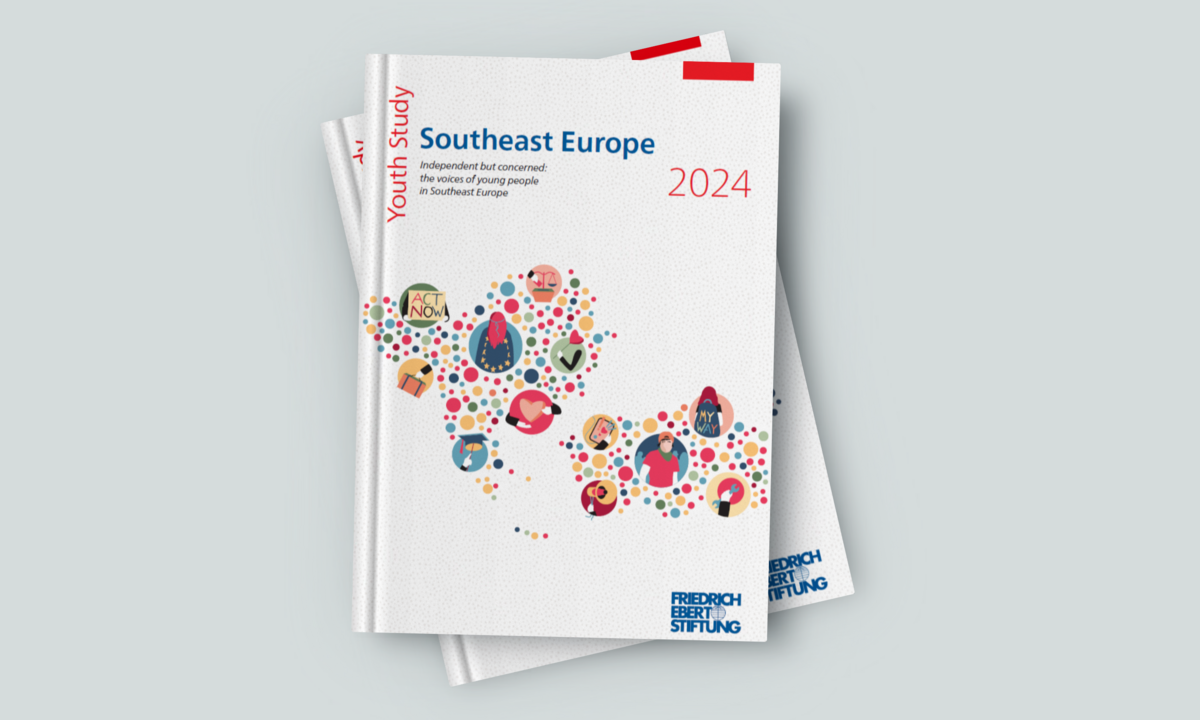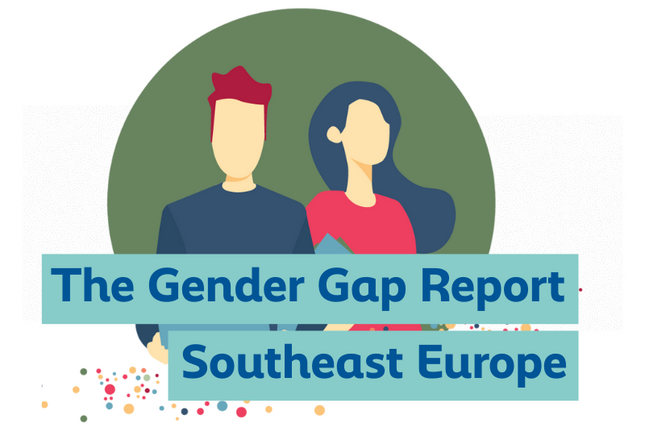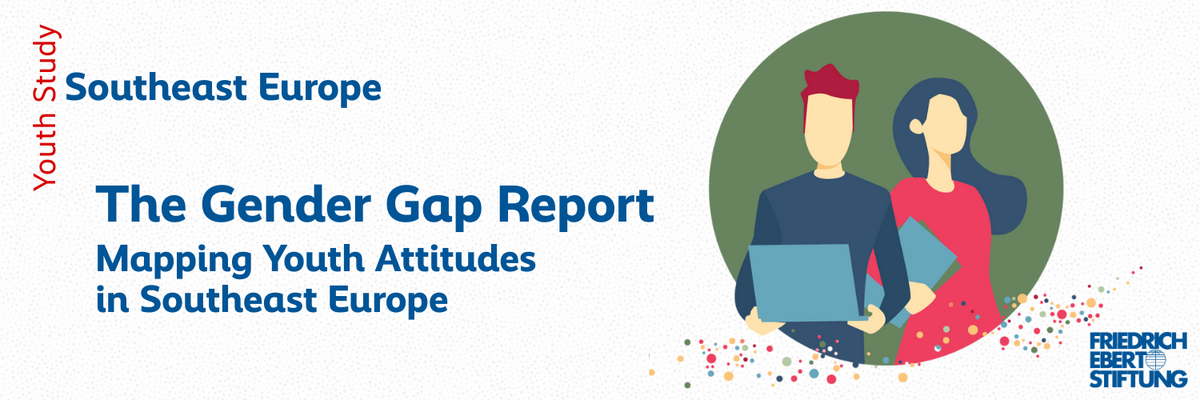
The Gender Gap Report Part II: What Young People Want in Partners
The dating preferences of young Southeast Europeans tell a story of subtle but persistent gender divides. The Friedrich Ebert Foundation's 2024 study across twelve countries asked young people "How important are the following to you when choosing a partner?" Respondents rated six criteria on a 1-5 scale from "not at all important" to "very important": religious beliefs, economic standing, family approval, virginity, education level, and national origin.
Men and women largely agree on the big picture—education tops everyone's wish list for partners. But dig deeper, and the differences emerge: women systematically value economic stability more highly, while men place greater weight on virginity. These gaps are not dramatic, but their consistency across cultures and borders hints at something deeper than individual taste.
The Economic Reality Check
The most significant gender gap in partner preferences is not about traditional values—it is about money. Young women rate economic standing as significantly more important than young men do, with a gap of 0.53 points on the importance scale. This represents the largest gender difference across all partnership criteria measured, with women averaging 3.21 compared to men's 2.67.

This economic pragmatism among young women could stem from the persistent gender wage gaps and employment insecurities that characterize the region's labor markets. When structural inequalities limit women's own economic opportunities, partner selection becomes a strategy for economic security. The pattern holds across the region but varies in intensity—Bosnia and Herzegovina shows the largest gap in economic considerations (-0.79), while Romania shows the smallest (-0.34).
Young women also prioritize education level more highly than men (3.46 vs 3.25), suggesting a broader pattern of valuing achievement and stability in partners. This combination of economic and educational preferences points to a generation of women approaching relationships with clarity about their material needs and aspirations.
The Virginity Divide
While women lead in economic pragmatism, men maintain significantly more traditional attitudes about sexual history. The importance of virginity shows the second-largest gender gap (0.49 points), with men rating it 2.64 compared to women's 2.15. This divide becomes even starker when examining who considers virginity "very important" in a partner.
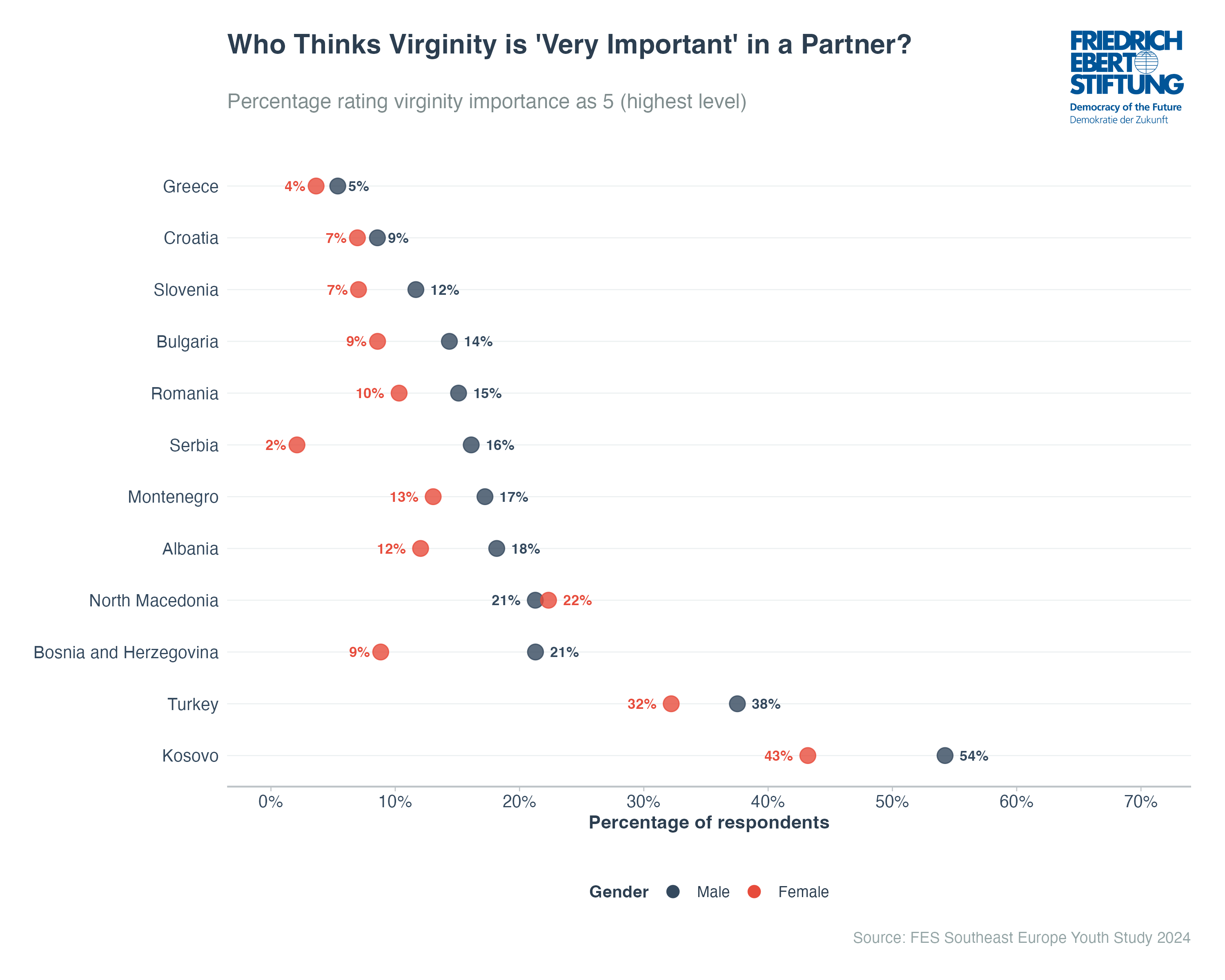
Kosovo presents the most extreme case: 54% of young men consider virginity "very important" compared to 43% of women—both figures far exceeding regional averages. Turkey follows with 38% of men and 32% of women rating virginity as very important. At the other end of the spectrum, Greece, Croatia, and Slovenia show single-digit percentages for women and relatively low rates for men, suggesting that EU membership correlates with more liberal sexual attitudes.
The persistence of these attitudes among young men, even as women increasingly reject them, creates a fundamental mismatch in relationship expectations. This asymmetry may contribute to relationship tensions and could partially explain declining marriage rates in some countries where traditional male expectations meet increasingly independent female realities.
The Gender Gap Landscape
The overall pattern of gender differences reveals that women value five out of six partnership criteria more highly than men, with only virginity showing higher importance for men.
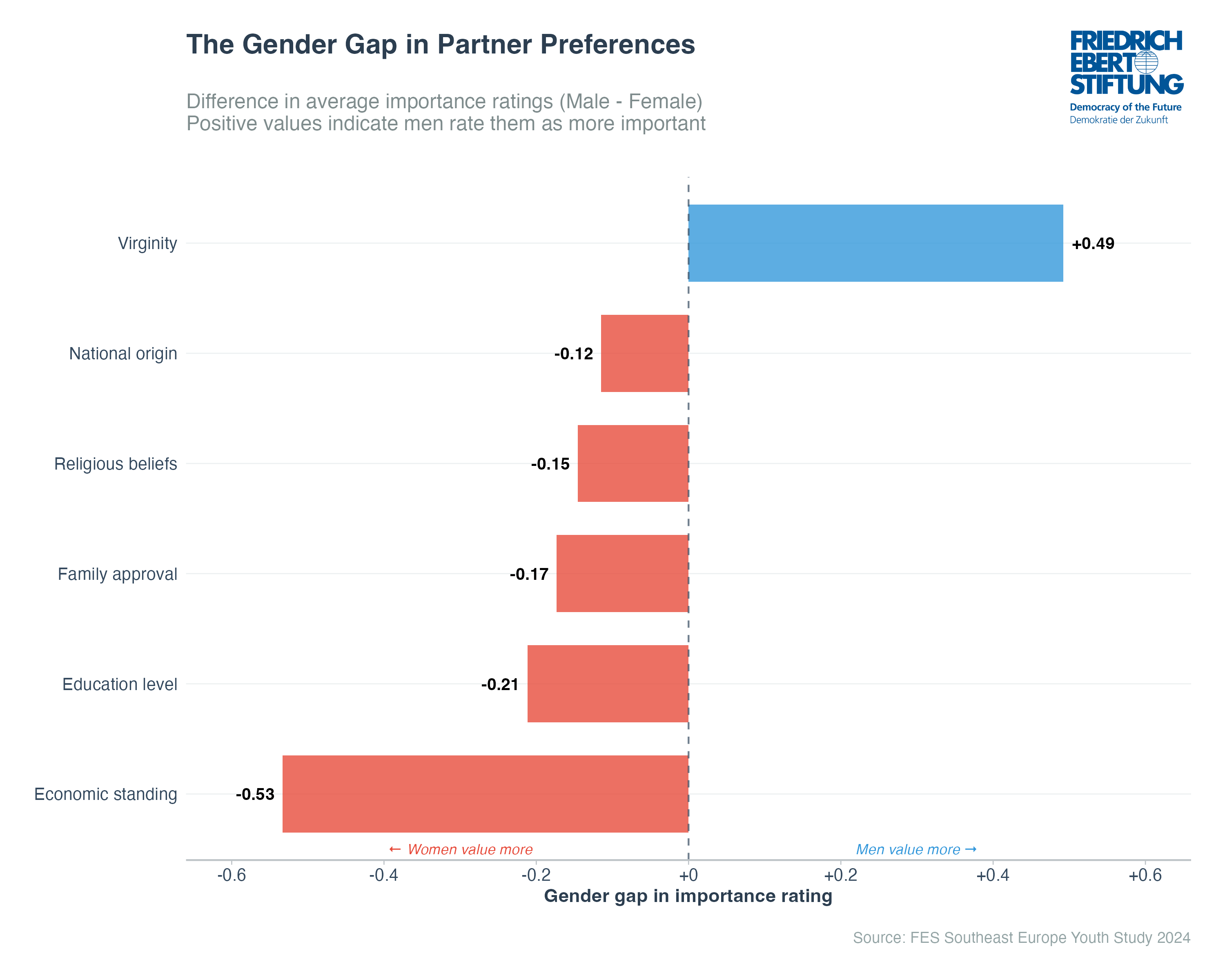
The criteria where women show higher preferences—economic standing (-0.53), education level (-0.21), family approval (-0.17), religious beliefs (-0.15), and national origin (-0.12)—paint a picture of comprehensive evaluation that considers both practical and social dimensions. Men's singular emphasis on virginity (+0.49) appears increasingly isolated as a gendered priority.
The Urban-Rural Divide That Is Not
Despite expectations of significant urban-rural divides, geographic location shows surprisingly small differences in partner preferences. Rural and urban youth want remarkably similar things from partners, with gender remaining by far the dominant factor shaping relationship priorities.
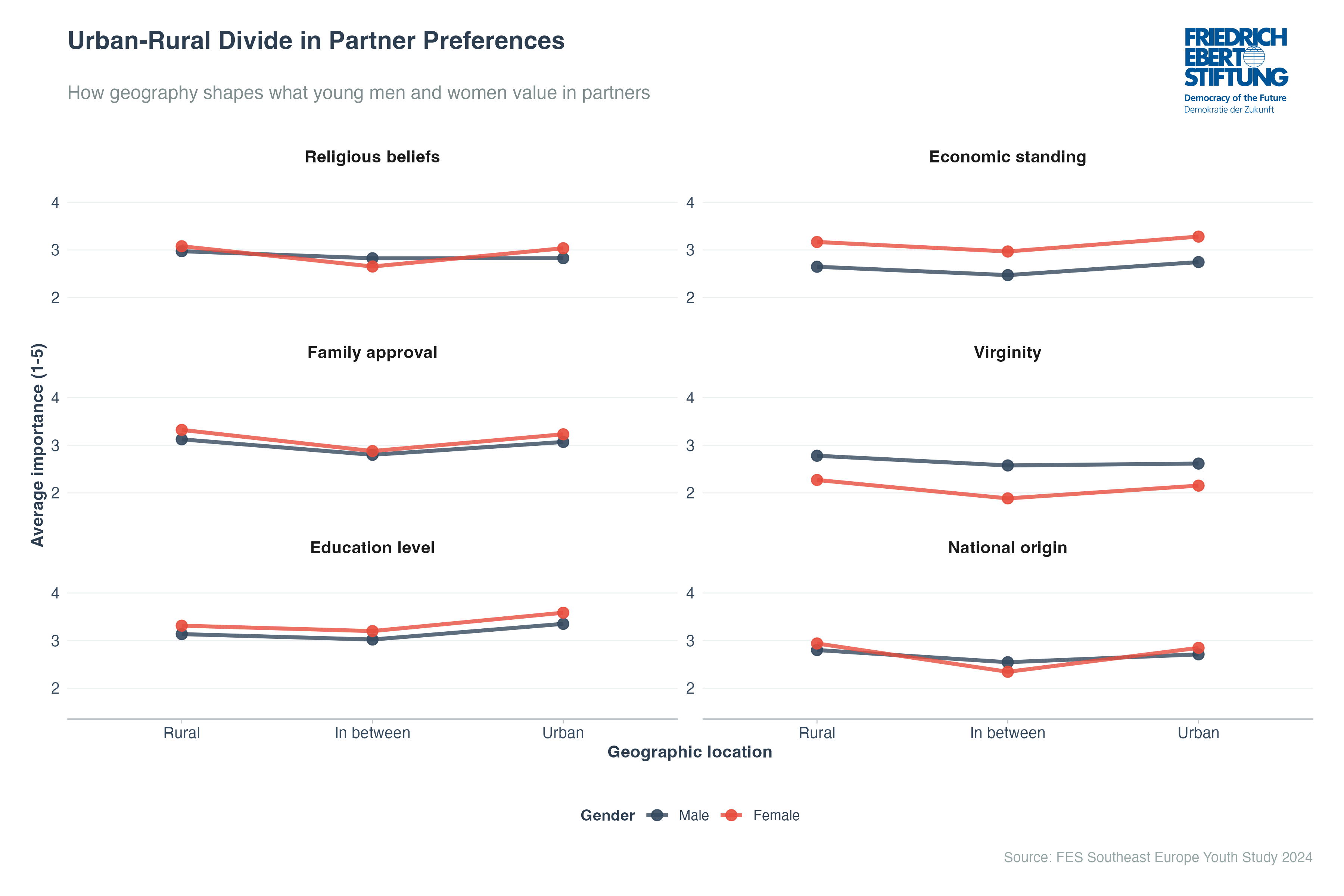
The traditional rural-urban comparison reveals minimal differences: rural youth rate virginity only slightly higher (2.52 vs 2.38), religious beliefs marginally more important (3.03 vs 2.93), and education somewhat less crucial (3.23 vs 3.47). These gaps are dwarfed by gender differences—women's stronger emphasis on economic standing (-0.53 gap) or men's greater focus on virginity (+0.49 gap) represent much larger divides than any rural-urban split.
Those living in mixed urban-rural environments do show more liberal attitudes across several criteria, particularly regarding virginity (2.25) and family approval (2.84). However, this "in between" category represents a specific transitional context rather than evidence of a broader geographic gradient.
The core finding challenges assumptions about geography and values: rural and urban youth in Southeast Europe have converged in their partnership priorities. Gender gaps persist consistently across all locations, suggesting that structural inequalities and cultural socialization patterns around masculinity and femininity matter more than whether someone lives in a city or countryside.
Education's Transformative Effects
Education levels create substantial differences in partnership preferences among 19-29 year olds, with some effects matching or exceeding major gender gaps. Higher education systematically increases the importance placed on most partner criteria, with family approval showing the steepest climb from 2.55 among those with low education to 3.23 for the highly educated—a gap of 0.68 points.
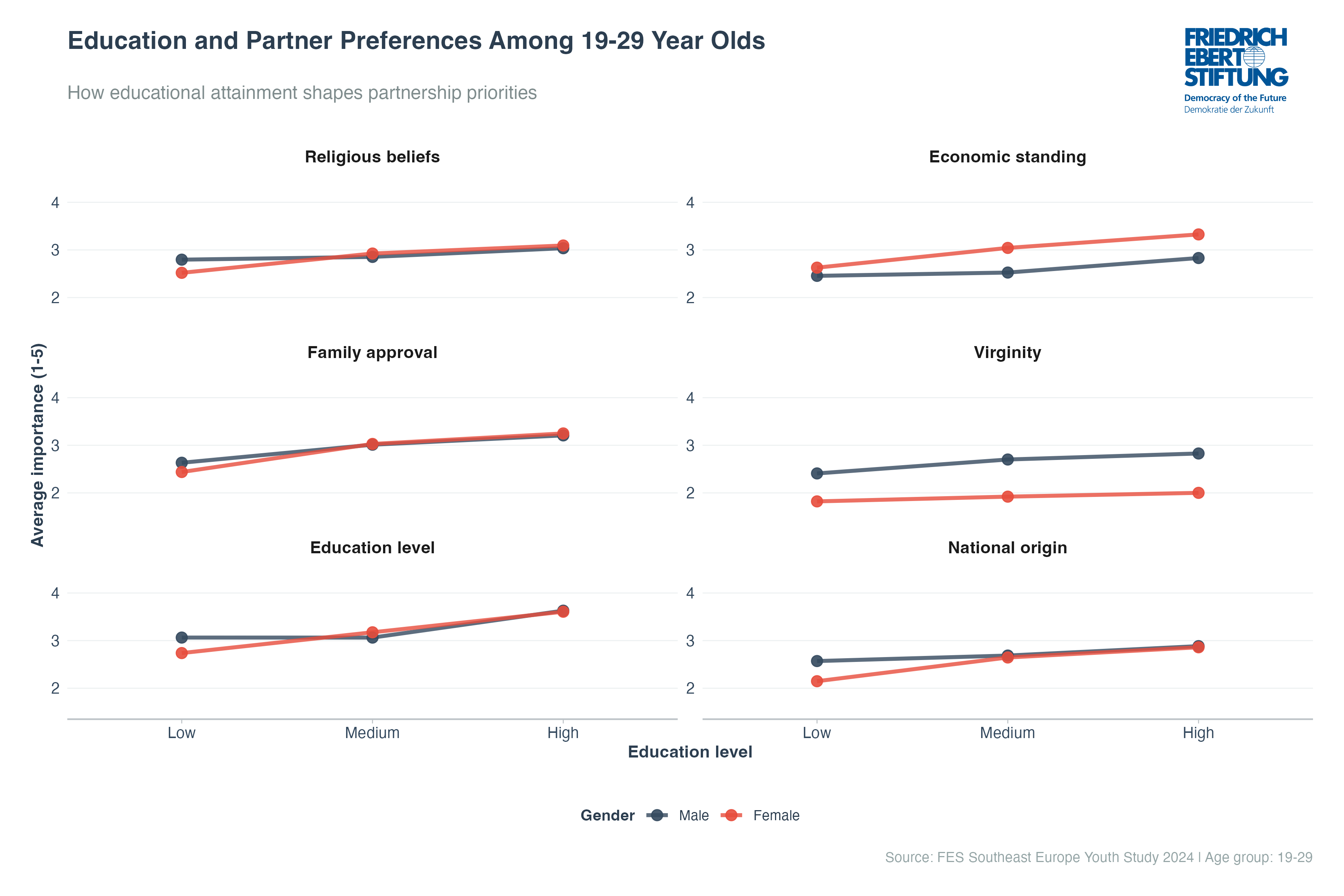
The most striking pattern appears in economic considerations, where education creates a 0.57-point increase (2.53 to 3.10)—comparable to major gender differences in the study. Highly educated youth also place more emphasis on their partner's education level (2.92 to 3.62) and religious beliefs (2.68 to 3.07), suggesting that higher education increases overall selectiveness rather than liberalizing attitudes. Even virginity shows the counter-intuitive pattern of increased importance with education (2.16 to 2.39), though this represents the smallest education effect.
Regional Patterns
The regional analysis reveals significant variation in the intensity of gender gaps across Southeast Europe, with some countries showing extreme polarization on certain issues while others maintain more moderate differences. Montenegro and Serbia lead with the largest single gender gaps in the region (0.87) on issues of economic standing and virginity, respectively, while countries like Romania and Bulgaria show consistently smaller divides.
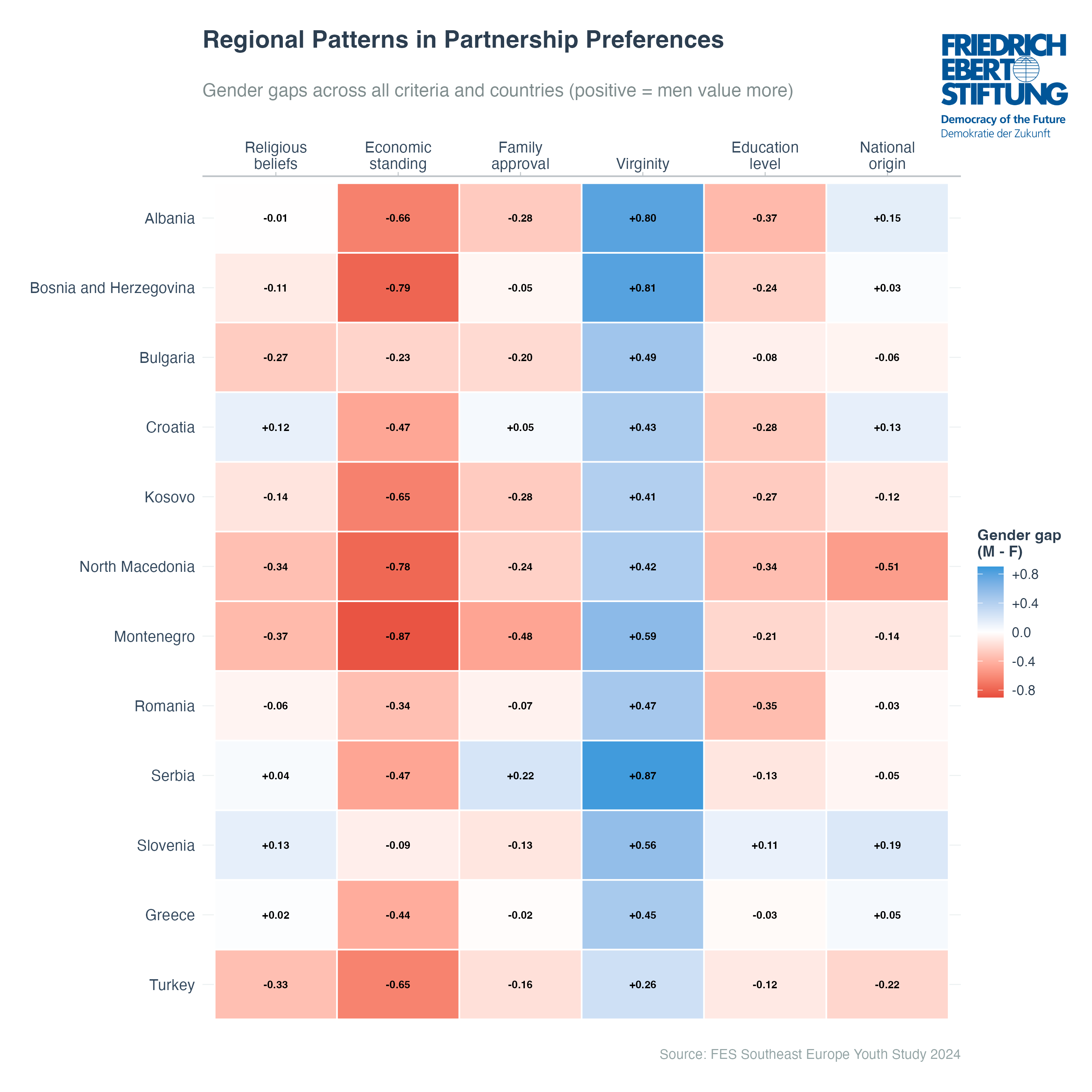
The High-Intensity Cluster: Montenegro, North Macedonia, Albania, and Bosnia and Herzegovina show the highest overall gender differentiation across all criteria. Montenegro leads in women's economic preferences (-0.87), while Serbia and Bosnia show the strongest male emphasis on virginity (+0.87 and +0.81 respectively).
The Moderate Middle: Croatia, Kosovo, Turkey, and Serbia show moderate differentiation, with significant gaps in some areas but more convergence in others. These countries typically show the regional pattern of women prioritizing economics while men emphasize virginity, but with less extreme differences (with the exception of virginity in Serbia).
The Convergent Group: Slovenia, Greece, Romania, and Bulgaria display the smallest overall gender gaps, suggesting greater convergence in partnership priorities. However, even these "egalitarian" countries maintain the basic regional pattern, just with reduced intensity.
North Macedonia stands out as a unique case, showing the strongest female-favoring preferences overall (2.21 sum) and the region's largest gender gap for national origin (-0.51), indicating distinctive ethnic or cultural dynamics not seen elsewhere in Southeast Europe.
Traditional vs Modern
To understand the deeper dynamics, we created indices comparing traditional values (virginity, religious beliefs, family approval) against modern values (education, economic standing). The results reveal that most countries cluster near the balance point but show clear gender differentiation.
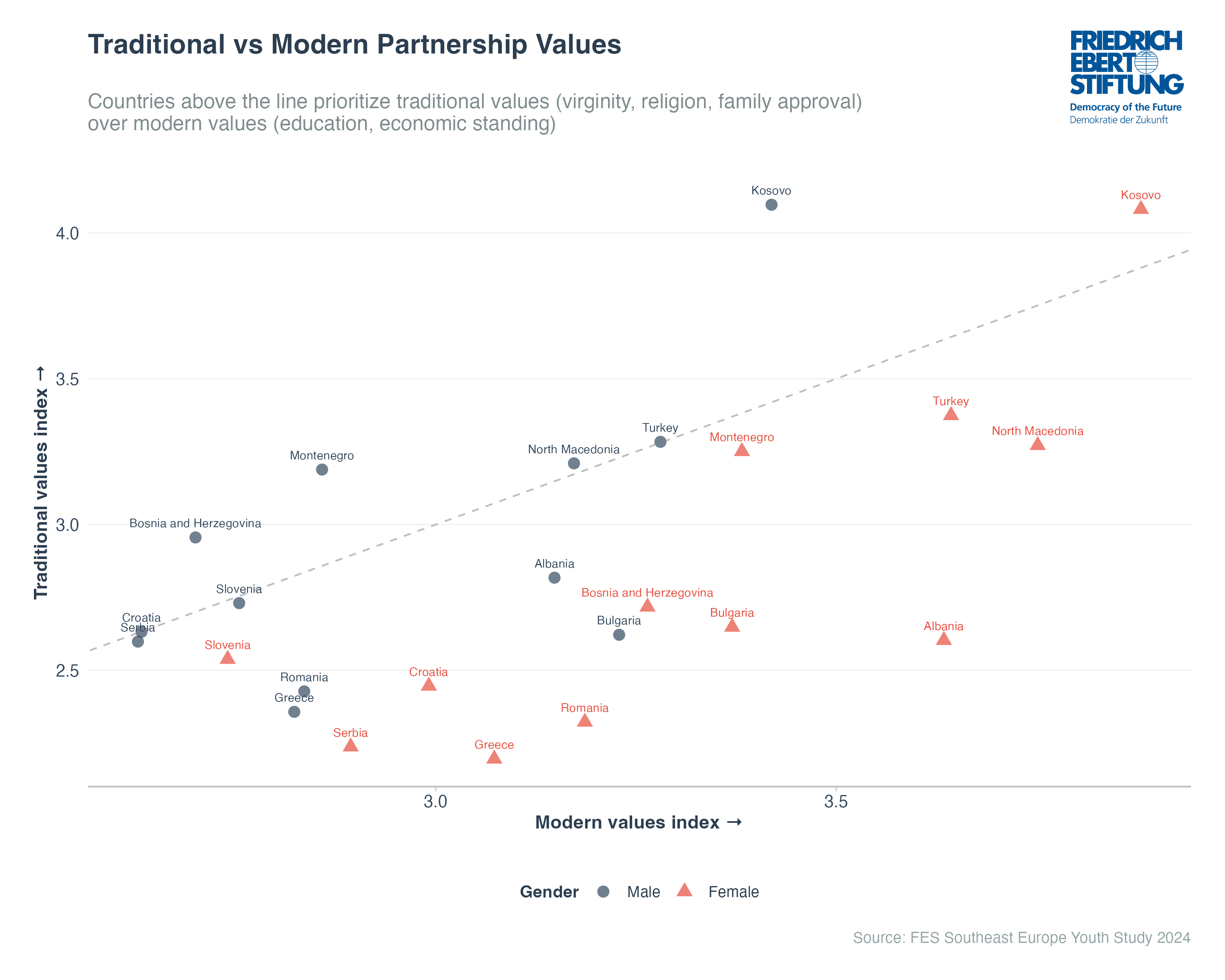
Kosovo stands as a clear outlier, with both genders showing the highest traditional values in the region, though men exceed women in this emphasis. Turkey, North Macedonia, and Montenegro form a second tier of traditional emphasis. At the modern end, Serbia, Greece, and Croatia show stronger emphasis on education and economic factors relative to traditional considerations.
Notably, women in every country except Kosovo show stronger modern value orientation than their male counterparts, reinforcing the pattern of female pragmatism versus male traditionalism. This systematic gender difference across diverse national contexts suggests that the forces shaping these preferences operate beyond specific cultural or religious traditions.
The Mismatch Crisis
The data reveals a fundamental mismatch in what young men and women seek in partners, with potentially profound implications for relationship formation and stability. Young women's focus on education and economic stability meets young men's persistent emphasis on virginity, creating conflicting expectations that may contribute to relationship difficulties.
As women become more educated and economically independent, they maintain or even increase their standards for partners' economic standing and education. Meanwhile, men's continued emphasis on virginity becomes increasingly anachronistic in societies where sexual activity before marriage is common. This mismatch may lead to mutual frustration and smaller pools of mutually acceptable partners.
Negotiating New Relationship Norms
The partnership preferences of Southeast European youth reveal a generation negotiating between inherited traditions and contemporary realities. The persistence of gender gaps—even as their content shifts—suggests that difference rather than convergence may characterize gender relations for the foreseeable future.
For young women, the data suggests a clear-eyed assessment of economic realities that makes partner selection strategic. Their higher overall selectiveness across most criteria reflects both raised expectations and persistent vulnerabilities that make partner choice consequential for life outcomes.
For young men, the continued emphasis on virginity represents either resistance to changing sexual norms or difficulty adapting expectations to new realities. This traditionalism, concentrated in specific countries, may become increasingly isolating as women's attitudes continue to liberalize.
The path forward likely requires explicit negotiation of these differences rather than hoping for natural convergence. Educational programs, public discourse, and policy interventions that address the mismatch in partnership expectations could help young people develop more compatible and realistic relationship frameworks. The alternative—persistent and growing gaps in what men and women want from each other—threatens both individual happiness and social cohesion across the region.
The Future of Love in Southeast Europe
As Southeast Europe continues its transformation, the intimate sphere of partner selection becomes an arena where tradition and modernity, pragmatism and idealism, equality and hierarchy compete for dominance. The data reveals not a simple story of progress or regression, but a complex negotiation where young people construct new relationship ideals from available cultural materials. The future of relationships in Southeast Europe depends on how successfully these young people navigate between what they have inherited and what they are creating.
About the Data
This analysis draws from the Friedrich Ebert Foundation's Southeast Europe Youth Study 2024, examining attitudes among young people aged 14-29 based on a survey of 8,943 respondents across Albania, Bosnia and Herzegovina, Bulgaria, Croatia, Kosovo, North Macedonia, Montenegro, Romania, Serbia, Slovenia, Greece, and Turkey.
Related publication
Hasanović, Jasmin ; Lavrič, Miran ; Adilović, Emina ; Stanojević, Dragan
Youth study Southeast Europe 2024
independent but concerned: the voices of young people in Southeast Europe

